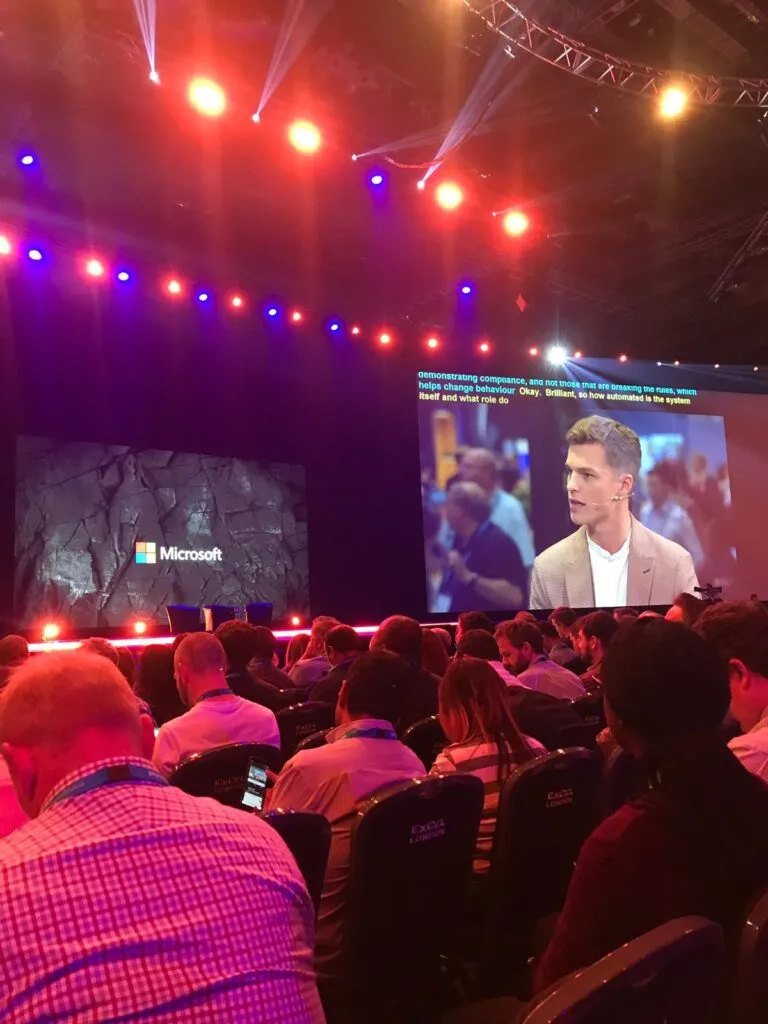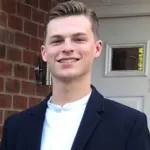
Going beyond your comfort zone: Why embracing uncertainty and saying yes matters
“Thirty seconds guys”, Eddie called, glancing over at his camera crew and then locking eyes with me. We shared a nod before I stared down the camera, trying to visualise one last time what I’d be doing in about 24 seconds from then.
One last look at my notes. “Ten seconds guys.” Deep breaths. Out of the corner of my eye, I saw a big, bold logo appear on the studio monitor showing the livestream, which meant the ad break must be wrapping up. Okay, just one more look at my notes. Head back up, looking straight down the lens now. “Three, two,” – start smiling like you’re on BBC Breakfast – “one…”
Going live
Four weeks ago today, I joined the Experiential team at Microsoft, which oversees events and brand experiences in the UK. Perfect timing, then, given that our biggest annual event, Future Decoded, was just three weeks away.
Every year, over two days, Future Decoded draws in thousands of attendees to the ExCeL in East London, who come to find out what new and exciting things Microsoft and its partners are up to. This year, the exhibition floor featured a 15ft-high ‘digital waterfall’, where a number of environmentally focused organisations were stationed, all of which had received grants through Microsoft’s AI for Earth programme. Alongside Microsoft UK CEO Cindy Rose and Chief Accessibility Officer Jenny Lay-Flurrie, keynote speakers in the auditorium included astronauts Major Tim Peake and Dr Helen Sharman, and Christian Horner, Red Bull F1 Team Principal.
So, towards the end of my first week in role, I heard that I would spend the next two working on ‘Future Decoded Live’. FD Live, as I soon learned, is a live-stream that runs throughout Future Decoded from a studio space on the Expo Floor, consisting mostly of breakfast TV-style conversations with a variety of partners, event sponsors and keynote speakers.
My job was to work out who was going to speak when, manage our own schedule against those of each guest, and then – the fun part – come up with a set of interview-style questions to guide the discussions. This meant I got to spend a lot of time researching and reading about some of the most interesting people and organisations at the event: the AI for Earth cohort, Channel 4, Adobe, the British Heart Foundation, Microsoft itself, and many more. Minus the keynotes, we had 12 hours of live video content to conjure up.
Embracing uncertainty
This would probably still feel like a fairly challenging task if I was given it in my second year – so, the prospect of taking it on in my second week felt adequately daunting. After sitting down with the FD Live lead for about an hour, I spent the rest of the day trying to get my head round the scope of the project, and how best to approach it. I had five documents to track and keep up-to-date, dozens of email threads to take over and who-knew-how-many questions to write.
I’m someone who likes structure and detail. I don’t like to begin working on something until I get a clear sense of how the whole thing fits together. Sometimes, this is great: a broad, yet in-depth understanding of a project helps me make sure everything is consistent and well-orchestrated from the bottom up. Other times, this is not so great: when progress is needed sooner rather than later, with details yet to be carved out. FD Live was an example of the latter, and the uncertainty I felt was only made bigger by the unshakeable fact that I was still just one week into the job.
I had to force myself to embrace this uncertainty, which – at first – felt unnatural, and sometimes stressful. I wrenched myself away from the need to have a clear, 360-degree view, and started work in the hope that some things would fall into place later. As it turned out, it wasn’t quite as bad as I thought. I felt able to work faster and with more focus, forgetting about the overall state of the project for a while and taking on one task at a time.
On reflection, this was one of the most valuable things I learned: to view projects as a jigsaw, rather than a painting. I don’t always need to paint the ‘big picture’ myself before making a start. The final image can come together gradually, piece by piece, and with the help of others.
Saying yes
A week later, things were coming together. Confirmations were coming in, the schedule was filling up, and I’d written questions for many of the speakers. I knew there was a lot more to do, but I had found a solid routine and felt nicely on top of things. I was responsible for something, I knew what I was doing. It felt good.
On Tuesday morning, with one week to go before the event, I had a call with the live-stream presenters to run through the questions I’d written so far. We were about halfway down the document, when we reached a session with WPP, on ‘creativity in AI’.
“These are probably my favourite questions. It’s a really cool topic”, I remarked. The call went quiet for a second or two, before someone asked – “Do you want to ask them on the day?” Before I’d even processed the question, my instincts told me to say no. I get painfully nervous before public speaking – although I’m usually pretty good at hiding it – and every time an opportunity comes my way, I know I’ve got a big mental battle on my hands. I bought myself a few more seconds with an “Oh, ummmm…”, as I increasingly sensed how much I wanted to do it, deep down. “I’ll have a think about it.”
I thought about it all evening. I knew how easy it would be to say ‘sorry, I don’t think I’m ready for this yet, but thanks for the opportunity. Maybe next year.’ But I knew I could do it. I probably wouldn’t sleep for 72 hours or so beforehand, but I could do it.
So I counted all the reasons why I should say yes: great exposure, hugely rewarding, a whole week to prepare, people around me who I knew would support me, and a really good topic for a LinkedIn blog post afterwards (…just kidding).
Then I counted the reasons why I should say no: because I felt scared… that was it. Once I had broken it down like that, I knew how much I would regret saying no. So, I sent a late-night IM and confirmed, before I had a chance to change my mind.

Learning from new experiences
I saw a tweet once which said something along the lines of ‘if you’re thinking about something that makes you quite excited, but very nervous, then you should probably do it.’
The best opportunities to learn and grow are nearly always found outside of our comfort zones. Sometimes, a little push is all that’s needed to take that step; this may come from our teams or ourselves, in our personal or professional lives.
The way I like to think about this is – if a friend came to me and said, ‘I’ve just got this really big opportunity, but I’m not sure I can do it because…’, I would try my very hardest to convince them that they could. If that’s the case, why should I behave any differently towards myself?
On the day of the interview, as I sat down on the studio sofa and looked at the camera, I felt a tide of nerves flowing around my chest – just like usual – but, for the first time in my life, I actually enjoyed it. This time, I embraced the nerves as a signal that I must be about to do something really worthwhile, something I had never done before.
“Thirty seconds guys…”
Find out more
‘How AI and satellites combat illegal fishing‘ – An interview with Nick Wise, CEO of OceanMind,
‘Creativity in AI‘ – An interview with Perry Nightingale, SVP Creative AI at WPP
Watch all the highlights from Future Decoded at FD Live
About the author
 Chester Broad is a new Microsoft Aspire Experience hire who recently graduated from the University of Bath, where he studied Management with Marketing. Now part of the Experiential Marketing team, Chester’s focus is on skills-based and internal events, through which he takes a keen interest in how the Microsoft brand can be communicated as an experience. Prior to this, he spent a year as an intern in the PR team.
Chester Broad is a new Microsoft Aspire Experience hire who recently graduated from the University of Bath, where he studied Management with Marketing. Now part of the Experiential Marketing team, Chester’s focus is on skills-based and internal events, through which he takes a keen interest in how the Microsoft brand can be communicated as an experience. Prior to this, he spent a year as an intern in the PR team.




